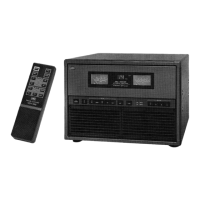2.2.2 CCB-367
PA
Control
CCB-367
PA
control is attached to the upper
s.ide
of the power amplifier unit and
is
·
equipped with a bias voltage control circuit for ,the two power amplifiers, a cooling fan
control circuit, protection circuits and an
inputpower
splitter.
1 )Power Amplifier Bias Voltage Control Circuit -
As the RF power MOSFET
of
CAH-377 power amplifier operates in class AB, the DC
bias voltage which determines the operating point current (idling ct.irrent) is
ess~ntial.
The gain of the power amplifier can be changed by changing the DC bias voltage.
!he
normal bias voltage is about 2.5V
DC.
However, the bias voltage varies accmd-
ing to the KEY signal state or.
the.
temperatu re change
of
the
heat
sink to get the
optimum gain of the power amplifier. · ·
IC4(1/4 to 4/4) and IC5(1/4 to 4/4) are DC amplifiers which send out a bias voltage to
the RF power MOSFET block of each SEPP circuit. This
biasvoltage
can be adjusted
with variable resistors
RV11
to RV14 and
RV21
to RV24. The reference voltage for
this bias voltage
is
obtained from the developed voltage between the base and the
emitter of
TR1
and TR2.
TR1
and TR2 are attached to the side part of the heat sink
of
CAH-377 power amplifier. As the base-emitter is driven
by
a constant current, the
base-emitter voltage depends.on the temperature of the heat sink. .
The base-emitter voltage is amplified by the DC amplifier IC3 (4/4) and sent to each
poweramplifier block
as
a bias
voltage.
As the RF power MOSFET, employed in the JRL-2000F, has a negative thermal.
coefficient, the gain decreases when the temperature of the heat sink rises. To com-
pensate this,
TR1
and TR2 check the temperature of the heat sink and operate to
keep the gain constant, regardless of the temperature change,
by
controlling the bias
voltage. ·
The comparator IC3 (3/4) controls the bias voltage by referencing the KEY signal.
Fig.2 shows each waveform of the signal voltage.
KEY
&
PTI
signal ® from outside, passes the time-constant circuit composed of
C1
and R2, and is switched by the comparator. The comparator output
@,
sent out from
No.14 pin of IC1, passes the time-constant circuit composed of
RS,
CD14 and C2, and
the DC amplifier IC3 (4/4) and then is formed to a signal voltage waveform
@.
The signal voltage waveform © is applied to the DC amplifiers IC3 (3/4) and IC (4/4),
and controls the bias voltage
of
each power amplifier
bloq_k.
The bias voltage
@varies
according to the KEY & PTT signal.
6
Downloaded
by
RadioManuai.EU

